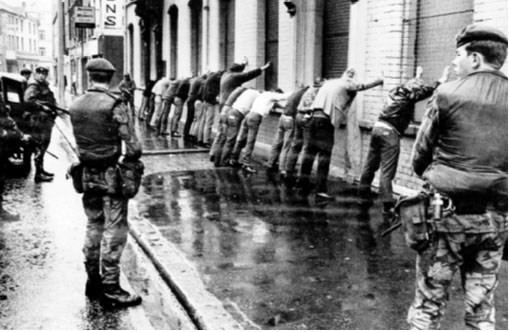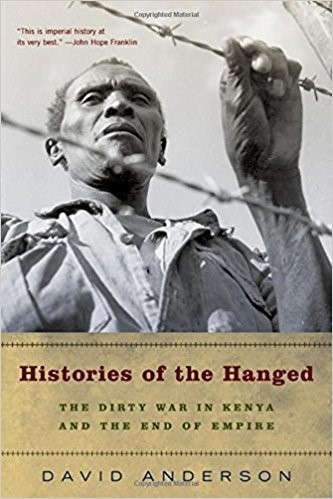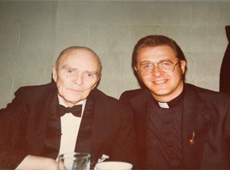Wiping History
Posted By: December 29, 2017
Mike Small. Bella Caledonia. Scotland. Wednesday, December 27, 2017

“Every record has been destroyed or falsified, every book rewritten, every picture has been repainted, every statue and street building has been renamed, every date has been altered. And the process is continuing day by day and minute by minute. History has stopped. Nothing exists except an endless present.” – George Orwell, 1984
On the day when Tony Blair has been made immune from prosecution in the High Court, we should remember also the words of his colleague Gordon Brown back in 2005. Returning from a trip to Kenya, Gordon Brown announced that Britain should stop apologizing for colonialism. We should be proud of our colonial history in Africa, he said and praised “British values” such as liberty, tolerance and civic virtue.
Such values can be witnessed in Histories of the Hanged: Britain’s Dirty War in Kenya and the End of Empire by David Anderson (Weidenfeld & Nicholson).
Anderson quotes one officer experience interviewing three enemy suspects. He says:
“One of them, a tall coal-black bastard, kept grinning at me, real insolent. I slapped him hard, but he kept on grinning at me, so I kicked him in the balls as hard as I could … When he finally got up to his feet, he grinned at me again, and I snapped. I really did. I stuck my revolver right in his grinning mouth … And I pulled the trigger. His brains went all over the side of the police station. The other two (suspects) were standing there looking blank … so I shot them both … when the sub-inspector drove up, I told him the (suspects) tried to escape. He didn’t believe me, but all he said was ‘bury them and see the wall is cleaned up.’”
The British State is trying to wipe its own history. But it’s not very good at it.
It’s role in complicity with the CIA’s ‘extraordinary rendition program,’ Britain’s use of torture in suppressing the Mau Mau Rebellion in Kenya in the 1950s and in Northern Ireland in the 1970s were just some of the thousands of secrets “lost” repressed and destroyed.
In fact, we now know that these things are connected, that the “counterinsurgency” techniques honed by the British Army in Africa were used in Ireland. This is a history of the British State, and it is no accident it’s being destroyed at this time, at this moment.

None of this deletion of history is new.
As a historian of the British Empire and author of ‘Britain’s Gulag: The Brutal End of Empire in Kenya‘ Caroline Elkins discovered:
“The overarching takeaway is that the government itself was involved in a very highly choreographed, systematized process of destroying and removing documents so it could craft the official narrative that sits in these archives. I never in my wildest dreams imagined this level of detail. I imagined it more of a haphazard kind of process.”
As freelance journalist Siobhan Fenton writes (“Why do archive files on Britain’s colonial past keep going missing?“):
“Many Britons have grown up believing their homeland saved and civilized the world, while atrocities, genocide and human rights abuses often go unmentioned. Successive governments have failed to narrow this knowledge gap, whether by setting up truth commissions, establishing a museum of colonialism or teaching schoolchildren about colonialism as part of the standard curriculum.
In 2014, a YouGov poll found that 59% of those surveyed thought the British empire was more something to be proud of than ashamed of.
The loss of these documents provides an apt metaphor for what colonialism means to many in Britain. Embarrassing facts are neatly filed away, labeled as “the past,” and on the rare occasions that the archives are inspected, damning evidence is nowhere to be seen.”
Dirty Wars and Countergangs
As we go out to create a “global Britain” this re-writing of history becomes more essential for myth-making and propaganda.
Writing in History Ireland in 2014 James Hughes (a professor of politics at the LSE) examines the key role of Frank Kitson in transferring the learning from the British Army abroad to Ireland, and how these ideas were then taken forward into Iraq and Afghanistan. In this sense, Siobhan Fenton’s revelations complete the circle.
Hughes writes:
“Recent developments have focused attention on the nature of British counterinsurgency as ‘dirty war,’ not only in Northern Ireland but also in several other anti-colonial struggles after World War II. In 2012 the British high court found that British troops perpetrated the Batang Kali massacre in Malaya in 1948. In 2013 Britain’s foreign secretary, William Hague, apologized and accepted that its security forces had tortured, mutilated and raped Mau Mau fighters, agreeing to compensate as many as 8,000 and to build a memorial in Nairobi. As a result of both of these investigations, an archive of colonial documents from Malaya, Kenya, Aden, Cyprus and other places of controversy, hitherto kept secret in breach of Britain’s Freedom of Information Act and amounting to 200 meters of shelving, was discovered.
Meanwhile, the Saville Report (2010) into Bloody Sunday and the de Silva Report (2013) on collusion with loyalist paramilitaries led to two further ‘unconditional’ British apologies for the behavior of its security forces in Northern Ireland. In November 2013, a BBC ‘Panorama’ investigation into British counterinsurgency in Northern Ireland in the early 1970s revealed that members of a special covert operations unit known as the Military Reaction Force (MRF) admitted to the murder of suspects and unarmed Catholic civilians. These admissions by the state or its agents confirm previous claims by critics dating back many decades. Such abuses were not merely low-level tactical excesses by undisciplined and racist troops but were institutional, systematic, and approved or covered up at the highest levels. Yet these conflicts were consistently interpreted almost universally by British academics as exemplifying the best practice of counterinsurgency.
Even as the new revelations about atrocities were being made, new publications by British historians and political scientists were uncritically extolling the British ‘model’ or ‘way’ of counterinsurgency, asserting that the many positive lessons to be drawn, especially from Northern Ireland, should be applied in Iraq and Afghanistan. This conclusion is also drawn by the British military’s Operation Banner report (2006) into its role in the North, and the claim informs the new JDP 3-40 (2010) counterinsurgency doctrine for the British Army. To term a 30-year-long war that ended in military stalemate and political compromise a ‘success’ is by any benchmark delusional.”
Central to all of this were the theories of Brigadier Frank Kitson.
Hughes again:
“Kitson’s book, Low-Intensity Operations, drew on the lessons of Britain’s colonial wars to elaborate a plan of action for coordinated political, military, legal and media operations against insurgents and subversives. Kitson’s main contributions to counterinsurgency theory are in essence fourfold.
Firstly, he stressed the centrality of controlling the population. The population-centric approach was a common lesson drawn by the RAND symposium of 1962. The approach is often concealed under terms such as ‘pacification,’ ‘stabilization’ or ‘winning hearts and minds.’ It contains a core, flawed, assumption—that the insurgents’ number is small and that most of the population are neutral.
This assumption has been replicated in the ‘Petraeus doctrine’ with disastrous outcomes in Iraq and Afghanistan. Kitson, however, reworked the Algerian lessons provided by French officers such as Trinquier and Galula. Like them, and following the experience of the Briggs Plan in Malaya in 1949 (when 600,000 Chinese rural ‘squatters’ were placed in concentration camps termed ‘new villages’), he concluded that population control was essentially about coercion and raising the costs for disloyalty, not winning by ideas: ‘conditions can be made reasonably uncomfortable for the population as a whole . . . To act as a deterrent towards a resumption of the campaign’. With regard to the classic Maoist formula that the relationship between guerrillas and their supporting community was akin to that between fish and water, Kitson observed: ‘If a fish has got to be destroyed it can be attacked directly by rod or net . . . But if rod and net cannot succeed by themselves it may be necessary to do something to the water. .’. Conceivably, he surmised, this could extend to ‘polluting the water.’ Moreover, the law would be ‘little more than a propaganda cover for the disposal of unwanted members of the public.’
Secondly, in his books Gangs and Counter-gangs (1960) and Bunch of five (1977) Kitson stressed the value of covert operations, the ‘turning’ of insurgents through ‘carrot and stick’ measures, and what he called ‘counter-gangs’ or ‘pseudo-gangs,’ which could infiltrate or deceive insurgents. He accounted for much of his tactical success against the Mau Mau by the turning of a resistance fighter code-named ‘George.’
Kitson adapted other experiences, notably the infiltration tactics of Edward Lansdale and Magsaysay against the Huk rebellion in the Philippines, and the covert assassination ‘Q’ squads organized by Roy Farran in Palestine.
Kitson proposed a ‘chain reaction system’ of intelligence-gathering whereby the accumulation of masses of low-grade ‘background intelligence’ (at this time kept in books and index cards but later computerized) would generate ‘contact information,’ which would then expose the enemy for elimination. This intelligence would come partly from informants, harsh interrogation of prisoners (he is a source for the persistence of the ‘five techniques’ in the British Army) and turning insurgents, and partly from covert operations—in Palestine and Aden this meant dressing up like Jews or Arabs, in Africa it required ‘blackening up’, and in Belfast plain clothes and civilian vehicles for the MRF.
Mostly, however, background information was to be gathered by cordons and mass ‘screening’ of populations, which required static fortified bases in occupied areas (what the French army termed ilôtage and quadrillage in their operations in Algeria from 1957). Fortified ‘forward operating bases’ (FOBs) were standard practice in Northern Ireland, and are a characteristic of the US-led interventions in Iraq and Afghanistan.
Kitson’s third contribution was to propose the use of ‘special units’ within the army to conduct counterinsurgency. He was a key proponent of incorporating the SAS into the army’s command structure, something that he advanced as a war office planner in 1958 through the use of the SAS in Oman. In his works, he also envisaged the use of ad hoc special units using ‘special people and specialized techniques’ but did not elaborate further. In essence, Kitson envisaged the para-militarization of the British Army, switching its focus from conventional to unconventional warfare, training troops ‘to support civil power’ in mock-ups of Belfast streets, adopting the techniques of insurgents, and fighting ‘terrorism’ with state terror units in the form of gang warfare.
Fourthly, Kitson was a pioneer of psyops (psychological operations) and media manipulation by briefing and spin, and he established close relationships with British journalists in Northern Ireland, turning them into ‘useful mouthpieces’ (as one journalist told the Saville Enquiry).”
It’s worth thinking about the immense propaganda and myth-making around the SAS that has gone on in popular culture in the last forty years, and well worth reflecting on the importance of this in light of a re-reading of British history.
As the future is re-written, and Brexit bile gets turned on Ireland, it is vital to remember record and disseminate this history. As Orwell told us: “The most effective way to destroy people is to deny and obliterate their own understanding of their history.”










